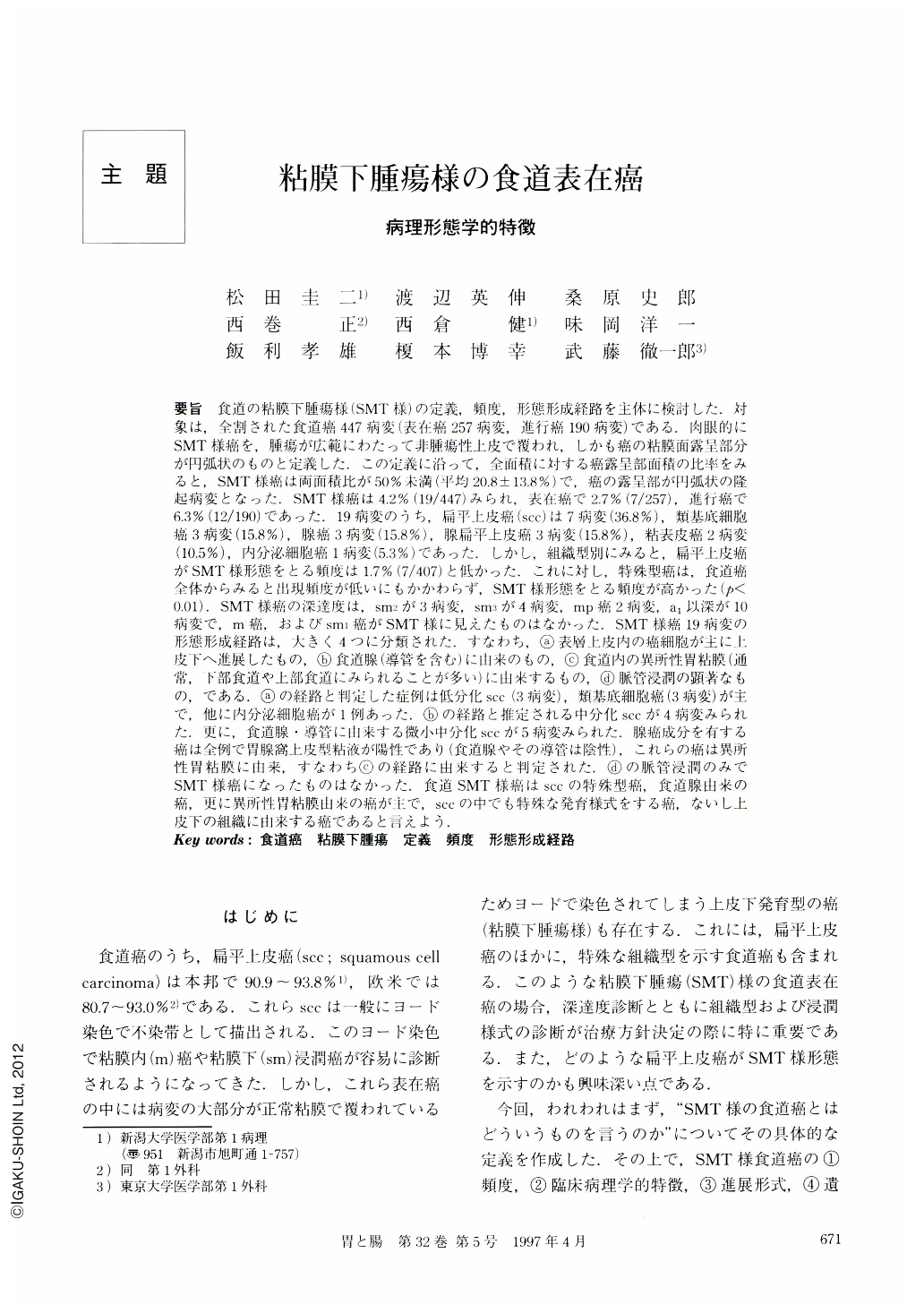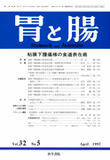Japanese
English
- 有料閲覧
- Abstract 文献概要
- 1ページ目 Look Inside
- サイト内被引用 Cited by
要旨 食道の粘膜下腫瘍様(SMT様)の定義,頻度,形態形成経路を主体に検討した.対象は,全割された食道癌447病変(表在癌257病変,進行癌190病変)である.肉眼的にSMT様癌を,腫瘍が広範にわたって非腫瘍性上皮で覆われ,しかも癌の粘膜面露呈部分が円弧状のものと定義した.この定義に沿って,全面積に対する癌露呈部面積の比率をみると,SMT様癌は両面積比が50%未満(平均20.8±13.8%)で,癌の露呈部が円弧状の隆起病変となった.SMT様癌は4.2%(19/447)みられ,表在癌で2.7%(7/257),進行癌で6.3%(12/190)であった.19病変のうち,扁平上皮癌(scc)は7病変(36.8%),類基底細胞癌3病変(15.8%),腺癌3病変(15.8%),腺扁平上皮癌3病変(15.8%),粘表皮癌2病変(10.5%),内分泌細胞癌1病変(5.3%)であった.しかし,組織型別にみると,扁平上皮癌がSMT様形態をとる頻度は1.7%(7/407)と低かった.これに対し,特殊型癌は,食道癌全体からみると出現頻度が低いにもかかわらず,SMT様形態をとる頻度が高かった(p<0.01).SMT様癌の深達度は,sm2が3病変,sm3が4病変,mp癌2病変,a1以深が10病変で,m癌,およびsm1癌がSMT様に見えたものはなかった.SMT様癌19病変の形態形成経路は,大きく4つに分類された.すなわち,(a)表層上皮内の癌細胞が主に上皮下へ進展したもの,(b)食道腺(導管を含む)に由来のもの,(c)食道内の異所性胃粘膜(通常,下部食道や上部食道にみられることが多い)に由来するもの,(d)脈管浸潤の顕著なもの,である.(a)の経路と判定した症例は低分化scc(3病変),類基底細胞癌(3病変)が主で,他に内分泌細胞癌が1例あった.(b)の経路と推定される中分化sccが4病変みられた.更に,食道腺・導管に由来する微小中分化sccが5病変みられた.腺癌成分を有する癌は全例で胃腺窩上皮型粘液が陽性であり(食道腺やその導管は陰性),これらの癌は異所性胃粘膜に由来,すなわち(c)の経路に由来すると判定された.(d)の脈管浸潤のみでSMT様癌になったものはなかった.食道SMT様癌はsccの特殊型癌,食道腺由来の癌,更に異所性胃粘膜由来の癌が主で,SCCの中でも特殊な発育様式をする癌,ないし上皮下の組織に由来する癌であると言えよう.
We mainly investigated the definition, frequency, and pathway leading to the production of the shape of esophageal submucosal tumor (SMT)-like carcinoma. The subjects were 447 esophageal carcinomas (superficial: 257 carcinomas, advanced: 90 carcinomas) which were totally sliced into 4mm-thick blocks. Macroscopically we defined SMT-like carcinoma as cancer which is widely covered by non-neoplastic epithelium and has a circular ulcer-margin. By measuring exposed area to total area of SMT-like carcinoma was below 50% 〔20.8 (average) ± 13.8 (SD)%〕. Frequency of SMT-like carcinoma was 4.2% (19/447) in all cancers, and 2.7% (7/257) in superficial carcinomas, and 6.3% (12/190) in advanced carcinomas. Out of 19 lesions, squamous cell carcinomas (sccs) were 7 lesions (36.8%), basaloid cell carcinomas 3 lesions (15.8%), adenocarcinomas 3 lesions (15.8%), mucoepidermoid carcinomas 2 lesions (10.5%), and small cell carcinoma 1 lesion (5.3%). But, the frequency of SMT-like tumors in total sccs was lower (1.7%, 7/407) than that of special type carcinomas (p<0.01). As to the depth of SMT-like carcinoma, sm2 was 3 lesions, sm3; 4 lesions, mp; 2 lesions, and a1 or deeper than a1; 10 lesions. The pathways leading to the production of the shape of 19 SMT-like carcinomas were divided into 4, i.e., (a) cancer cells in the basal and parabasal layer of intraepithelial carcinoma spread into the subepithelial area, (b) cancer cells originating from the esophageal gland or duct, (c) cancer cells originating from ectopic gastric mucosa, (d) severe lymphatic or venous permeation of cancer cells. Cases judged as pathway (a) were 3 poorly differentiated sccs, 3 basaloid cell carcinomas and 1 endocrine cell carcinoma. Four moderately differentiated sccs were analogized as pathway (b). Furthermore, 5 moderately differentiated microscopic sccs were observed originating from the esophageal gland or duct. All esophageal carcinomas with components of adenocarcinoma were positive for gastric foveolar type mucus, 45M1 (this is negative for the esophageal gland or duct), so they were judged as pathway (c) origin. No SMT-like carcinomas originated from only lymphatic or venous permeation.
These results conclude that SMT-like carcinomas of the esophagus were sccs with special growth patterns or those originating from subepithelial tissue.

Copyright © 1997, Igaku-Shoin Ltd. All rights reserved.


